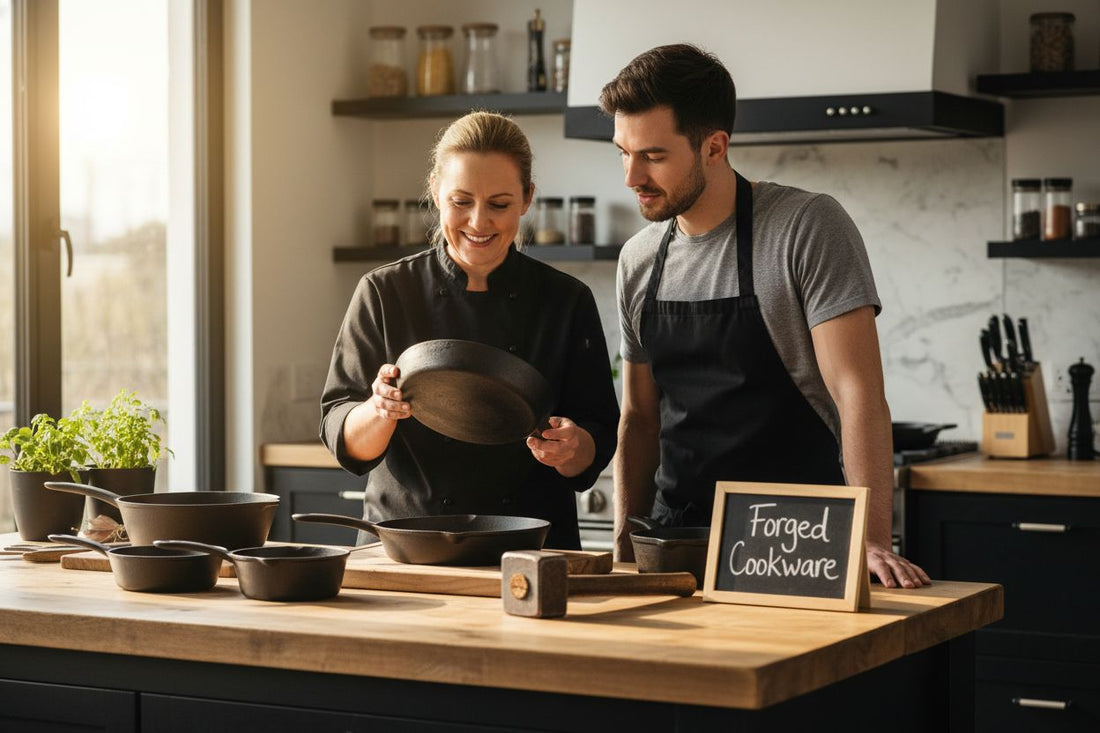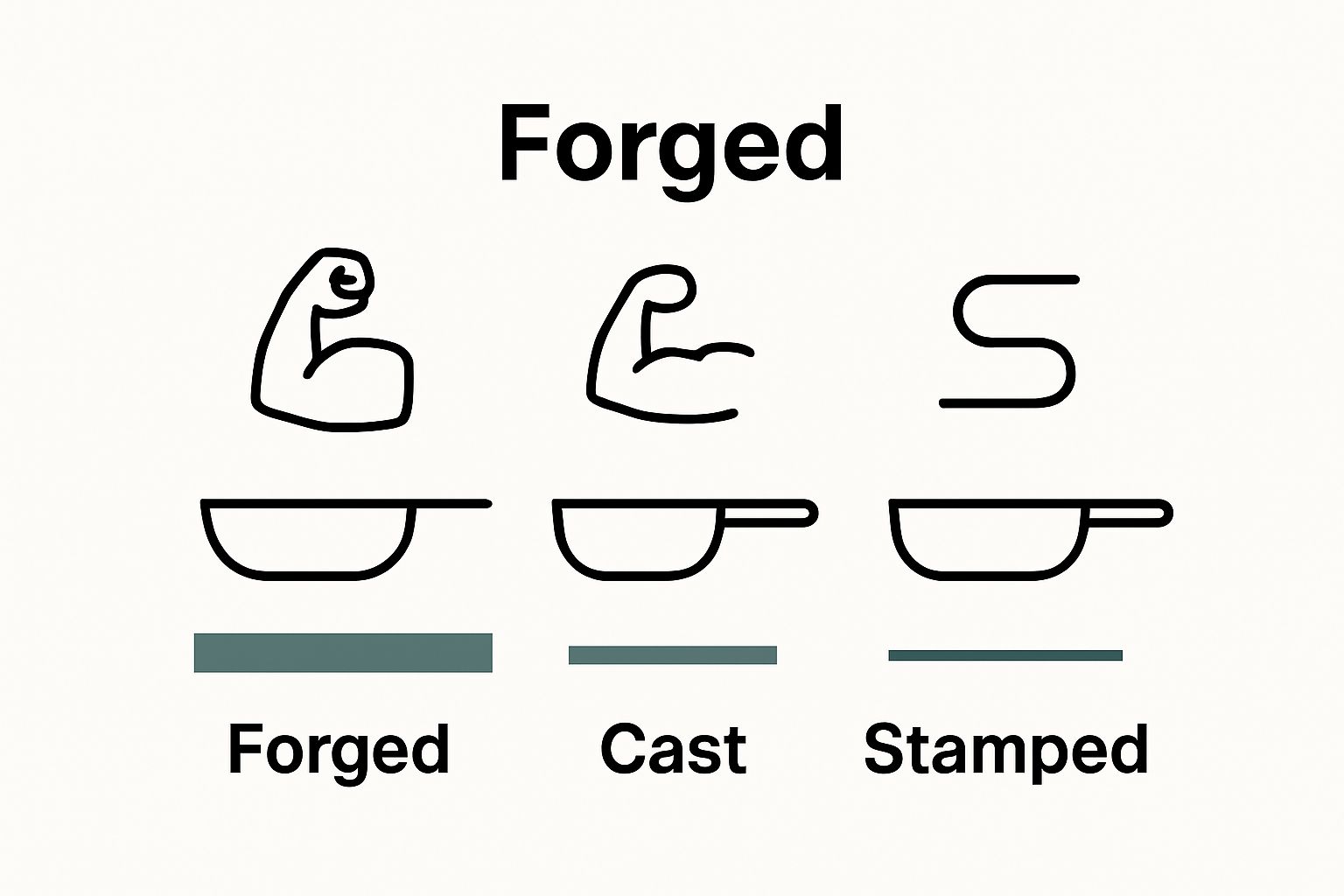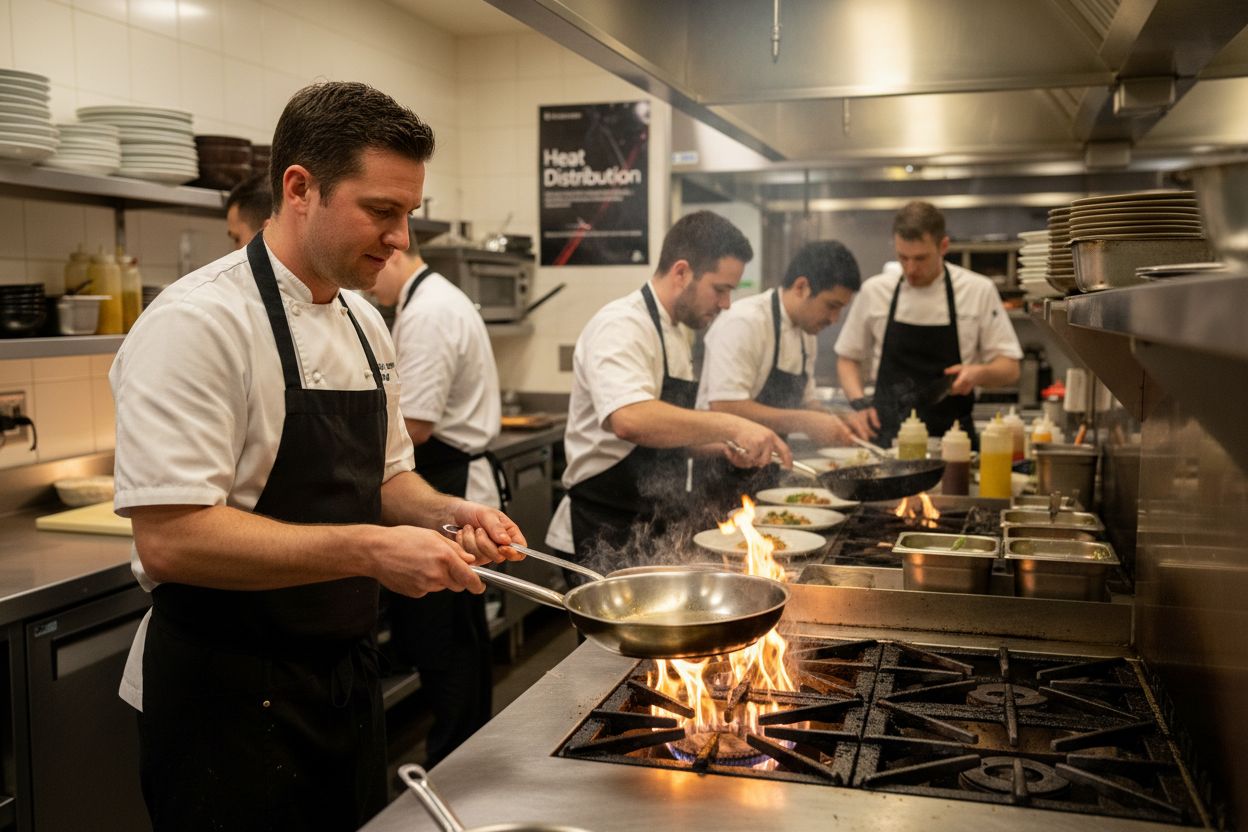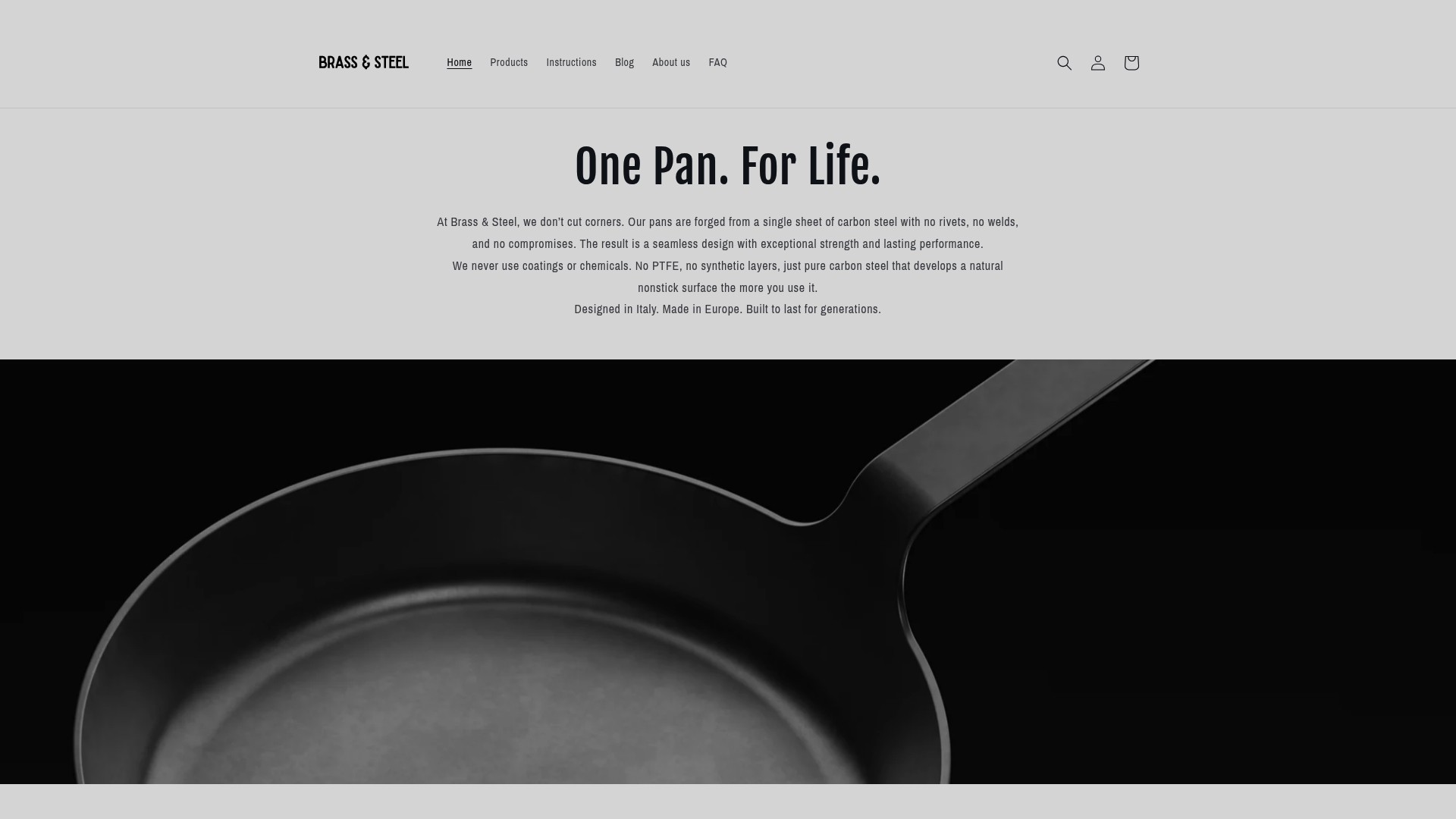
What is Forged Cookware? Understanding its Benefits and Use
Share
Forged cookware has developed a reputation for being the tool of choice in top kitchens, known for strength and reliability on the hob. You might think a thick slab of metal is all it takes to make a chef’s pan, yet the real difference comes from what happens under extreme pressure and heat. During the forging process, metal is heated to up to 70 percent of its melting point and reshaped with hydraulic force, fundamentally changing its internal structure and performance. The biggest surprise? This method does not just make pans tougher – it transforms how evenly and quickly they cook, turning every meal into a display of precision engineering.
Table of Contents
- Defining Forged Cookware: What It Is and How It’s Made
- The Importance of Material Quality in Forged Cookware
- Understanding the Advantages of Using Forged Cookware
- How Heat Distribution Works in Forged Cookware
- Applications of Forged Cookware in Professional Kitchens
Quick Summary
| Takeaway | Explanation |
|---|---|
| Forged cookware offers superior strength and durability. | The forging process enhances metal structure, leading to cookware that withstands more intense culinary environments. |
| Material quality affects cooking performance significantly. | High-quality metals ensure excellent heat management and lasting reliability in the kitchen. |
| Superior heat distribution optimises cooking precision. | Forged cookware distributes heat evenly, allowing for rapid responses to temperature changes and minimising hot spots. |
| Forged cookware adapts to various cooking techniques. | Its robust design makes it suitable for high-temperature searing, oven finishing, and delicate sauce preparation. |
| Consistent performance under professional stress is crucial. | Forged cookware maintains cooking quality and resists wear, making it ideal for busy commercial kitchens. |
Defining Forged Cookware: What It Is and How It’s Made
Forged cookware represents a premium manufacturing technique that transforms raw metal into high-performance cooking equipment through sophisticated metalworking processes. Unlike traditional cast or stamped cookware, forged pieces undergo a complex transformation that fundamentally alters their molecular structure and mechanical properties.
The following table summarises the key differences between forged, cast, and stamped cookware as discussed in the article, aiding in quickly distinguishing their structural and performance traits.
| Cookware Type | Manufacturing Process | Key Structural Traits | Performance Characteristics |
|---|---|---|---|
| Forged | Heated and shaped under immense | Compressed molecular structure, uniform | Superior strength, durability, even heat |
| pressure with hydraulic force | density, enhanced resistance to warping | distribution, quick temperature response | |
| Cast | Poured molten metal in a mould | Thicker but more porous, potential | Good heat retention but less uniform heat |
| for internal stress | distribution, prone to warping under sudden change | ||
| Stamped | Cut from a metal sheet and pressed | Thinner, less structurally dense | Lightweight, heats up quickly but may warp |
| into shape | easily and lacks even heat |
The Metallurgical Process of Forging
Forging involves applying immense pressure and heat to shape metal, a technique that dramatically enhances its structural integrity. Scientific research from materials engineering reveals that this process compresses and realigns metal grains, creating a more uniform and robust material composition.
The forging process typically involves several critical stages:
- Heating metal to extremely high temperatures (often 70% of its melting point)
- Applying concentrated mechanical pressure using hydraulic presses or hammers
- Systematically reshaping the metal while maintaining its core structural properties
- Controlling cooling rates to optimise molecular grain structure
Distinctive Characteristics of Forged Cookware
Forged cookware distinguishes itself through several remarkable attributes. The manufacturing method produces cookware with superior strength, enhanced durability, and more consistent heat distribution compared to conventionally manufactured alternatives.
Key characteristics include:
- Exceptional tensile strength due to compressed molecular structure
- Reduced internal stress and improved structural uniformity
- Enhanced resistance to warping and deformation

- More precise and controlled metal thickness
By understanding the intricate metallurgical process behind forged cookware, culinary professionals and enthusiasts can appreciate why these cooking tools represent such a significant advancement in kitchen technology. Read more about professional kitchen cookware materials to explore how manufacturing techniques impact cooking performance.
The Importance of Material Quality in Forged Cookware
Material quality represents the fundamental cornerstone determining the performance, durability, and overall cooking experience of forged cookware. Professional chefs and culinary enthusiasts understand that superior material selection directly influences cooking precision, heat management, and long-term kitchen equipment reliability.
Metal Composition and Performance
The selection of metal composition plays a critical role in defining cookware characteristics. Materials science research from Industrial Metallurgy Journal demonstrates that specific metal alloys contribute unique properties to cookware performance.
Premium forged cookware typically emphasises metals with exceptional thermal conductivity and structural integrity:
- Carbon steel with high thermal responsiveness
- Stainless steel offering corrosion resistance
- Alloy metals providing enhanced strength and durability
- Specific grain structures enabling superior heat distribution
Critical Material Quality Indicators
Discerning cookware quality requires understanding several key material performance indicators. Professional kitchens prioritise materials that demonstrate consistent thermal behaviour, mechanical strength, and long-term resilience.
This table outlines the critical material quality indicators highlighted in the article, serving as a quick reference for what professionals look for in high-performance forged cookware.
| Material Indicator | Description |
|---|---|
| Thermal conductivity rate | Ability of the material to transmit heat efficiently |
| Mechanical stress resistance | Strength of the cookware when subject to force or pressure |
| Uniform heat distribution | Consistency of temperature across the pan surface |
| Corrosion and wear resistance | Durability against rust, wear, and reaction with ingredients |
| Minimal thermal expansion | Low degree of deformation when exposed to high temperatures |
Critical evaluation metrics include:
- Thermal conductivity rate
- Mechanical stress resistance
- Uniform heat distribution capabilities
- Corrosion and wear resistance
- Minimal thermal expansion
By carefully selecting materials with superior metallurgical properties, manufacturers can create cookware that transforms cooking from a basic task into a precision culinary experience. Explore our comprehensive guide on professional kitchen cookware materials to understand how material science revolutionises cooking equipment design.
Understanding the Advantages of Using Forged Cookware
Forged cookware offers professional chefs and passionate home cooks an exceptional cooking tool that transcends traditional kitchen equipment. The manufacturing process creates cookware with remarkable performance characteristics that significantly elevate culinary preparation and overall cooking experience.
Superior Structural Performance
Industrial metallurgy research demonstrates that forged cookware exhibits extraordinary mechanical properties, particularly in terms of durability and structural integrity. The forging process compresses metal grains, creating a more robust and resilient cooking surface that withstands intense culinary environments.
Key structural advantages include:
- Enhanced mechanical strength compared to cast alternatives
- Reduced internal stress within metal composition
- Improved resistance to deformation and warping
- More uniform material density across entire cooking surface
Thermal Management and Cooking Precision
Professional chefs prioritise cookware that provides consistent and responsive heat distribution. Forged cookware excels in thermal management, offering superior heat conductivity and precise temperature control that transforms cooking techniques.
Thermal performance benefits encompass:
- Rapid and uniform heat transmission
- Exceptional temperature stability
- Minimal hot spots during cooking
- Quick response to temperature adjustments
By selecting forged cookware, culinary professionals invest in equipment that combines scientific engineering with practical kitchen performance. Discover more about professional cookware technologies to understand how advanced manufacturing techniques revolutionise cooking tools.
How Heat Distribution Works in Forged Cookware
Heat distribution represents a critical performance metric that distinguishes forged cookware from conventional kitchen equipment. Professional chefs understand that precise thermal management directly impacts cooking quality, ingredient transformation, and overall culinary outcomes.
Thermal Conductivity Mechanics
Energy science research reveals that forged cookware’s unique molecular structure enables exceptional heat transmission capabilities. The compressed metal grains created during forging process facilitate rapid and uniform energy transfer across the cooking surface.
Key thermal conductivity principles include:
- Minimised molecular resistance to heat flow
- Uniform energy transmission across entire surface
- Rapid temperature equalisation
- Consistent heat retention
Precision Temperature Control Mechanisms
Forged cookware’s thermal performance transcends basic heat distribution. The manufacturing technique creates a cooking surface with remarkable responsiveness, allowing chefs to make instantaneous temperature adjustments with unprecedented precision.
Critical temperature control features encompass:
- Immediate reaction to heat source modifications
- Minimal temperature fluctuations
- Rapid cooling and heating capabilities
- Predictable thermal behaviour across different cooking techniques
By understanding these intricate thermal dynamics, culinary professionals can leverage forged cookware as a sophisticated instrument for precise cooking.
 Explore professional cookware material comparisons to deepen your understanding of advanced cooking technologies.
Explore professional cookware material comparisons to deepen your understanding of advanced cooking technologies.
Applications of Forged Cookware in Professional Kitchens
Professional kitchens demand cookware that can withstand intense culinary environments while delivering exceptional performance across diverse cooking techniques. Forged cookware emerges as a superior solution that meets the rigorous standards of high-performance culinary environments.
Versatile Cooking Technique Adaptability
Culinary Institute of America research demonstrates that forged cookware provides unparalleled versatility across multiple cooking methods. The robust construction allows chefs to seamlessly transition between different heat application techniques without compromising equipment integrity.
Key versatile cooking applications include:
- High temperature searing
- Precise oven finishing
- Delicate sauce preparation
- Complex reduction techniques
- Rapid stir frying
- Professional braising methods
Performance Under Professional Pressure
Commercial kitchens require cookware that maintains performance under continuous, high-intensity usage. Forged cookware’s exceptional structural integrity ensures consistent cooking results while resisting the mechanical stress of professional cooking environments.
Critical performance characteristics encompass:
- Sustained thermal stability
- Resistance to kitchen impact
- Consistent cooking performance
- Minimal maintenance requirements
- Extended equipment lifecycle
By integrating forged cookware, professional kitchens elevate their culinary capabilities through scientifically engineered cooking instruments. Explore our comprehensive guide to professional kitchen cookware to understand how advanced materials transform cooking performance.
Experience the True Power of Forged Carbon Steel Cookware
If you have just discovered the impressive science behind forged cookware and want to enjoy uncompromising performance in your own kitchen, you are closer than ever to a professional upgrade. Many home cooks and chefs struggle with flimsy pans that warp, struggle to heat evenly, and disappoint when it matters most. By choosing one-piece forged carbon steel, you embrace strength, precise heat control, and natural nonstick power without relying on synthetic coatings. Explore how our Carbon Steel Collection embodies these principles—all forged in a single piece for lasting reliability.

Why settle for less when you can cook with heirloom-quality pans engineered for durability and trusted by serious cooks? See the difference a pure carbon steel pan makes in searing, sautéing, and oven work. Visit Brass & Steel’s main site to begin your journey, or browse our expert range now to make your next meal unforgettable. If you wish to learn more about our meticulous approach to craftsmanship or find the perfect size for your kitchen, explore the full line at Carbon Steel Collection | Brass&Steel and take the first step towards better cooking today.
Frequently Asked Questions
What is forged cookware?
Forged cookware is high-performance cooking equipment made through a process that involves applying heat and pressure to raw metal, enhancing its strength and durability compared to traditional cast or stamped cookware.
What are the advantages of using forged cookware?
Forged cookware offers superior tensile strength, uniform heat distribution, reduced warping, and excellent thermal management, making it an ideal choice for both professional chefs and culinary enthusiasts.
How does heat distribution work in forged cookware?
The forging process compresses metal grains, enabling exceptional thermal conductivity. This results in rapid and uniform heat transmission across the cooking surface, allowing for precise temperature control during cooking.
What materials are typically used in forged cookware?
Premium forged cookware often features materials such as carbon steel, stainless steel, and specific metal alloys, contributing to enhanced strength, corrosion resistance, and superior thermal performance.
Recommended
- Understanding Forged Cookware Explained for Chefs & Enthusiasts – Brass & Steel
- 10 Essential Items for Your Professional Kitchen Cookware List – Brass & Steel
- 7 Essential Insights on Different Cookware Materials – Brass & Steel
- What is Carbon Steel Pan? Understanding Its Benefits and Uses – Brass & Steel